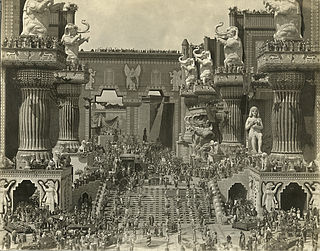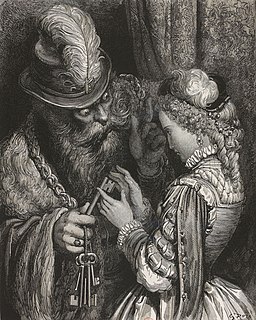
Bluebeard's Castle is a one-act expressionist opera by Hungarian composer Béla Bartók. The libretto was written by Béla Balázs, a poet and friend of the composer, and is written in Hungarian, based on the French literary tale La Barbe bleue by Charles Perrault. The opera lasts only a little over an hour and there are only two singing characters onstage: Bluebeard, and his new wife Judith ; the two have just eloped and Judith is coming home to Bluebeard's castle for the first time.

The Bloody Chamber is a collection of short fiction by English writer Angela Carter. It was first published in the United Kingdom in 1979 by Gollancz and won the Cheltenham Festival Literary Prize. The stories share a theme of being closely based upon fairytales or folk tales. However, Carter has stated:
My intention was not to do 'versions' or, as the American edition of the book said, horribly, 'adult' fairy tales, but to extract the latent content from the traditional stories.
The Brides of Dracula are characters in Bram Stoker's 1897 novel Dracula. They are three seductive female vampire "sisters" who reside with Count Dracula in his castle in Transylvania, where they entrance men with their beauty and charm, and then proceed to feed upon them. Dracula provides them with victims to devour, mainly infants and children.
Julaybib was a martyr and one of the less known companions of Prophet Muhammad in the early Muslim community. His name was acquired prior to his acceptance of Islam and is considered unusual and incomplete. In the Arabic language Julaybib means "small grown" being the diminutive form of the word jalbab, indicating that Julaybib was small and short, even dwarf-like. He was also described as being damim, meaning ugly, deformed, or repulsive.

Barbe-bleue is an opéra bouffe, or operetta, in three acts by Jacques Offenbach to a French libretto by Henri Meilhac and Ludovic Halévy based on Charles Perrault's 1697 story.

"The Robber Bridegroom" is a German fairy tale collected by the Brothers Grimm, tale number 40. Joseph Jacobs included a variant, Mr Fox in English Fairy Tales, but the original provenance is much older; Shakespeare alludes to the Mr. Fox variant in Much Ado About Nothing, Act 1, Scene 1:

"Fitcher's Bird" is a German fairy tale collected by the Brothers Grimm, tale number 46.

Bluebeard is a 1944 film noir directed by Edgar G. Ulmer, starring John Carradine in the title role. The film is based on the famous French tale Barbe bleue that tells the story of a violent nobleman in the habit of murdering his wives and the attempts of one wife to avoid the fate of her predecessors. The film is registered in the public domain.
Bluebeard is the title character in a 1697 fairy tale by Charles Perrault.

Ariane et Barbe-bleue is an opera in three acts by Paul Dukas. The French libretto is adapted from the symbolist play of the same name by Maurice Maeterlinck, itself loosely based on the French literary tale La Barbe bleue by Charles Perrault.

Pharaoh's daughter is a figure in the Hebrew Bible who is described as marrying Solomon to cement a political alliance between the United Monarchy of Israel and Egypt.

Charlotte Lucie Marie Adèle Stephanie Adrienne Faës, known by her stage name Jeanne d'Alcy or Jehanne d'Alcy, was a French film actress. She was the wife of French cinema pioneer Georges Méliès from 1925 until his death in 1938.

Bluebeard's Eighth Wife is a 1938 American romantic comedy film made by Paramount Pictures, directed and produced by Ernst Lubitsch, and starring Claudette Colbert and Gary Cooper. The film is based on the French play, La huitième femme de Barbe-Bleue, by Alfred Savoir and the English translation of the play by Charlton Andrews. The screenplay was the first of many collaborations between Charles Brackett and Billy Wilder. A much-married business tycoon meets his match in his latest wife.
Very Blue Beard is a 1979 Soviet musical comedy animated film loosely based on the Bluebeard fairy tale by Charles Perrault. Directed by Vladimir Samsonov, screenplay by Arkady Arkanov. Cinematography by Vladimir Milovanov. Original music score by Gennady Gladkov. Lyrics by Yuliy Kim. Released by T/O Ekran
Conomor, also known as Conomerus or Conomor the Cursed, was an early medieval ruler of Brittany. His name, which has the Welsh cognate Cynfawr, means "Great Dog", but could also indicate "Sea Dog" in early Brythonic. Conomor was notorious for his cruelty, becoming a legendary villain in Breton culture. He is widely regarded as one of the probable sources for the myth of Bluebeard and possibly also of Tristan's uncle King Mark of Cornwall. The wife-beating giant Cormoran may also retain a garbled folk memory of the same character.

Herzog Blaubarts Burg (1963) is a film of the opera Bluebeard's Castle by the Hungarian composer Béla Bartók, written in 1911 to a symbolist libretto by the poet and later film theorist Béla Balázs. The film was made for West German television, Süddeutscher Rundfunk, and was produced by Norman Foster, who also performs the lead role. The designer was Hein Heckroth who brought in his old friend Michael Powell, for whom he had designed a number of films, to direct it. The film, which was shot at Dürer Film Ateliers in Salzburg, Austria, was out of circulation for decades because of legal problems.
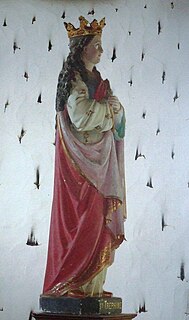
Saint Tryphine is a semi-legendary Breton saint whose life is often considered to be the basis of the story of Bluebeard. In Brittany she is widely revered as a patron saint of sick children and those whose birth is overdue. The legend of Saint Tryphine probably derives from a historical individual who was the wife of the early Breton ruler Conomor.
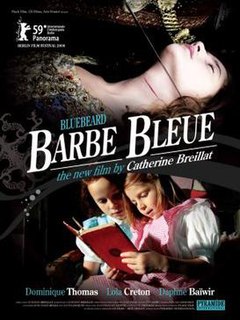
Bluebeard is a 2009 French drama fantasy film written and directed by Catherine Breillat and starring Lola Créton. It is based on the classic fairy tale Bluebeard, by Charles Perrault.
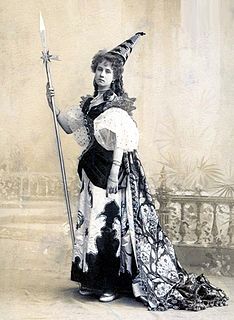
Barbe-bleue is a ballet-féerie in three acts and seven scenes, originally choreographed by Marius Petipa to the music of Pyotr Schenk. The libretto was created by the author and dramatist Countess Lydia Pashkova from the fairy tale Bluebeard by Charles Perrault. The ballet was first presented by the Imperial Ballet on December 20 [O.S. December 8] 1896 at the Imperial Mariinsky Theatre in St. Petersburg, Russia, the first performance being a benefit in honor of Marius Petipa's fiftieth anniversary in service to the St. Petersburg Imperial Theatres.


